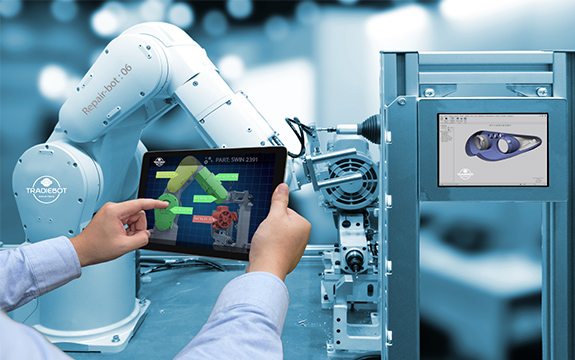Swinburne University of Technology has collaborated with Sydney-based industrial automation firm Tradiebot Industries and automotive aftercare company AMA Group to 3D print a replacement lug for an automotive headlamp assembly using a robotic arm.
Initially funded by a sum of $1,264,695 AUD (approx. $994 thousand USD) in 2018, the collaboration is part of the ‘Repairbot’ project, which is backed by the Innovative Manufacturing Cooperative Research Centre (IMCRC). The organization is a not-for-profit, independent cooperative research centre launched by the Australian government to help Australian companies increase their global relevance.
As part of the Repairbot project, Swinburne, Tradiebot and AMA Group are developing an automated, 3D printed repair service for cars. The project aims to create a low cost repair service that can be commercially implemented with same-day fixes of damaged vehicles.
“The Repairbot project is a great example of industry and research collaboration. The researchers at Swinburne have wholeheartedly embraced Tradiebot’s idea of developing a technology-driven solution that will automate the repair service for automotive plastic parts,” explained David Chuter, CEO and Managing Director of IMCRC.
“Reaching this major milestone demonstrates how committed they are to pushing materials and technology boundaries to help solve an industry specific problem that has the potential to not only transform Tradiebot’s business but the whole automotive repair industry. IMCRC as a collaborative partner is proud to help catalyse these transformative outcomes.”

A step towards automated 3D printing car repairs
The 3D printing of the lug directly onto the housing of the headlight was engineered by the robotics team at Swinburne, led by Dr Mats Isaksson. The team used a robotic arm to hold and precisely maneuver the headlight underneath a stationary 3D printing head. This meant the robotics team could 3D print the complex geometries of the replacement lug without the use of support material.
Dr Isaksson sees the development of the 3D printed lug as a major step towards constructing a complete prototype for automatic repairs of headlight assemblies. He also cited the collaborative element of the project as key to the success of the project so far: “The truly cross-disciplinary nature of this project has made it possible to develop new materials and methodologies hand-in-hand with the novel robotic solutions.”
Swinburne’s materials scientist Dr Mostafa Nikzad also developed an in-house formulated polypropylene composite material to guarantee compatibility with automotive grade injection moulded plastic. The material had the required properties for 3D printing polypropylene, as well as meeting automotive quality standards, thus enabling the robotics team to carry out the successful 3D printing of the replacement lug.
Mario Dimovski, founder of Tradiebot, commented “It’s amazing to witness something I envisioned three years ago becoming reality. It was such a complex project with many challenges to overcome. What the Swinburne team have delivered is Australian innovation at its best.”
“The Repairbot will allow repairs to be conducted on damaged automotive plastic parts not currently repairable by technicians. The benefits will affect repair shops, consumers and flow on to the environment diverting these damaged parts from landfill. It’s a win, win for everyone.”

Impacting the automotive and repair industries
Several leading car manufacturers have utilised 3D printing in recent years in the construction of their vehicles. Lamborghini has used 3D printed components from Carbon in the construction of its Urus Super SUVs. Ford on the other hand has opened an Advanced Manufacturing Center in Redford, Detroit, where it is 3D printing parts for the upcoming Ford Shelby Mustang GT500 sports car to save costs.
As well as cutting costs in the production of end-use parts, 3D printing in the automotive industry has already demonstrated the ability to save thousands in tooling costs as well, compared to traditional machining processes. The Repairbot project has the potential to have a similar impact, having already already garnered attention from various corners of the repair industry, as well as other industries, including defence.
Subscribe to the 3D Printing Industry newsletter for the latest news in additive manufacturing. You can also keep connected by following us on Twitter and liking us on Facebook.
Looking for a career in additive manufacturing? Visit 3D Printing Jobs for a selection of roles in the industry.
Featured image shows robotic arm holding headlight underneath 3D printing head. Screengrab via Tradiebot.


